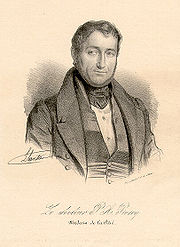
Pierre Adolphe Piorry
Encyclopedia

France
The French Republic , The French Republic , The French Republic , (commonly known as France , is a unitary semi-presidential republic in Western Europe with several overseas territories and islands located on other continents and in the Indian, Pacific, and Atlantic oceans. Metropolitan France...
physician born in Poitiers
Poitiers
Poitiers is a city on the Clain river in west central France. It is a commune and the capital of the Vienne department and of the Poitou-Charentes region. The centre is picturesque and its streets are interesting for predominant remains of historical architecture, especially from the Romanesque...
. He invented pleximetry
Pleximeter
A Pleximeter is a device used in percussion to absorb the energy generated by the strike from the plexor.During percussion the middle finger of examiner's hand is routinely used as pleximeter. The finger of the examiner's left hand is firmly applied to the chest wall so as to displace any air...
(a method for the investigation of internal organs using percussion
Percussion (medicine)
Percussion is a method of tapping on a surface to determine the underlying structure, and is used in clinical examinations to assess the condition of the thorax or abdomen. It is one of the four methods of clinical examination, together with inspection, palpation and auscultation...
) and was the creator of medical terms toxin
Toxin
A toxin is a poisonous substance produced within living cells or organisms; man-made substances created by artificial processes are thus excluded...
, toxemia
Toxemia
Toxemia may refer to:* A generic term for the presence of toxins in the blood, see Bacteremia* An outdated medical term for Pre-eclampsia...
and septicemia.
He studied medicine in Paris
Paris
Paris is the capital and largest city in France, situated on the river Seine, in northern France, at the heart of the Île-de-France region...
, where his instructors included Jean-Nicolas Corvisart
Jean-Nicolas Corvisart
Jean-Nicolas Corvisart was an important figure in the history of French medicine. Born in the French village of Dricourt, Ardennes in 1755, Corvisart gained early notoriety for his translation of Leopold von Auenbrugg's Inventum Novum from Latin into French...
(1755-1821), Gaspard Laurent Bayle
Gaspard Laurent Bayle
Gaspard Laurent Bayle was a French physician. He studied medicine under Jean-Nicolas Corvisart , and was a colleague to René Laënnec . Beginning in 1805 he practiced medicine at the Charité in Paris...
(1774-1816), François Broussais (1772-1838), and François Magendie
François Magendie
François Magendie was a French physiologist, considered a pioneer of experimental physiology. He is known for describing the foramen of Magendie. There is also a Magendie sign, a downward and inward rotation of the eye due to a lesion in the cerebellum...
(1783-1855). While still a student he was part of the Napoleonic Wars
Napoleonic Wars
The Napoleonic Wars were a series of wars declared against Napoleon's French Empire by opposing coalitions that ran from 1803 to 1815. As a continuation of the wars sparked by the French Revolution of 1789, they revolutionised European armies and played out on an unprecedented scale, mainly due to...
in Spain. In 1816 he earned his doctorate with a thesis titled Du danger de la lecture des livres de médecine par les gens du monde (On the danger of reading medical text books by the laity). He later became an esteemed professor of medicine at the Charité, Pitié
Pitié-Salpêtrière Hospital
The Pitié-Salpêtrière Hospital is a teaching hospital located in Paris, France. Part of the Assistance publique - Hôpitaux de Paris, it is one of Europe's largest hospitals...
, and Hôtel Dieu
Hôtel-Dieu de Paris
The Hôtel-Dieu de Paris is regarded as the oldest hospital in the city of Paris, France, and is the most central of the Assistance publique - hôpitaux de Paris hospitals. The hospital is linked to the Faculté de Médecine Paris-Descartes...
of Paris. In 1832 he was appointed to the Salpétrière, where he conducted clinical lectures.
He was inspired by René Laennec
René Laennec
René-Théophile-Hyacinthe Laennec was a French physician. He invented the stethoscope in 1816, while working at the Hôpital Necker and pioneered its use in diagnosing various chest conditions....
's invention of the stethoscope
Stethoscope
The stethoscope is an acoustic medical device for auscultation, or listening to the internal sounds of an animal body. It is often used to listen to lung and heart sounds. It is also used to listen to intestines and blood flow in arteries and veins...
(1816) and his publication of De l' Auscultation Médiate (1819). In 1826 Piorry invented the pleximeter
Pleximeter
A Pleximeter is a device used in percussion to absorb the energy generated by the strike from the plexor.During percussion the middle finger of examiner's hand is routinely used as pleximeter. The finger of the examiner's left hand is firmly applied to the chest wall so as to displace any air...
(le plessimétre), a device used to assist in outlining internal organs, of which he described in his treatise De la Percussion Médiate (1828).
He published works on numerous aspects of medicine, and had some success as a poet. One of his better known poems was Dieu, L'Ame et la Nature (1853).

